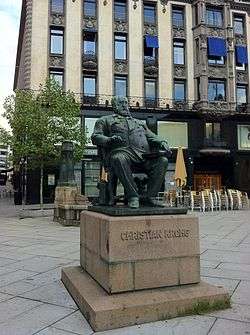Asbjørg Borgfelt
Asbjørg Borgfelt (31 October 1900 – 5 June 1976) was a Norwegian sculptor.[1]
Asbjørg Betty Borgfelt | |
|---|---|
| Born | 31 October 1900 Kristiania, Norway |
| Died | 5 June 1976 (aged 75) Oslo, Norway |
| Nationality | Norwegian |
| Known for | Sculpture |
| Spouse(s) | |

Biography
Asbjørg Betty Borgfelt was born in Kristiania (now Oslo), Norway. She was the daughter of Samuel Borgfeldt (1872-1936) and Magnhild Telma Sæther (1876-1941). Her father was an architect. Borgfeldt first studied art in Kristiania at the Norwegian National Academy of Craft and Art Industry (Statens Håndverks- og Kunstindustriskole) with Wilhelm Rasmussen (1879–1965). Then she studied in Copenhagen at the Royal Danish Academy of Fine Arts under Einar Utzon-Frank (1888-1955). She was awarded the Henrichsens legat; Mohrs legat (1937), Klaveness' stipend (1964) and Oslo bys stipend (1971). She made several study trips in Denmark, Germany, France and Italy.[2]
She won 1st prize in several competitions including the fountain Bjørnefontene at Majorstua in Oslo (1924–25), Oksefontenen at Torshov in Oslo (1926), the Christian Krohg monument (together with Per Hurum) in Oslo (1950) and for Årets kull at the Bergen Teacher Training College (which was unveiled in 1977 after the artist's death). Among her other public works are the bronze group Mor og barn (together with Per Hurum) from 1939–44 at the City Hall Square in Oslo. [3]
Personal life
In 1937 she married sculptor Per Hurum (1910–1989).[3]
References
- Godal, Anne Marit (ed.). "Asbjørg Borgfelt". Store norske leksikon (in Norwegian). Oslo: Norsk nettleksikon. Retrieved 9 October 2015.
- Erik Mørstad. "Asbjørg Betty Borgfelt". Norsk kunstnerleksikon. Retrieved 1 April 2018.
- Nordhagen, Per Jonas. "Asbjørg Borgfelt". In Helle, Knut (ed.). Norsk biografisk leksikon (in Norwegian). Oslo: Kunnskapsforlaget. Retrieved 9 October 2015.